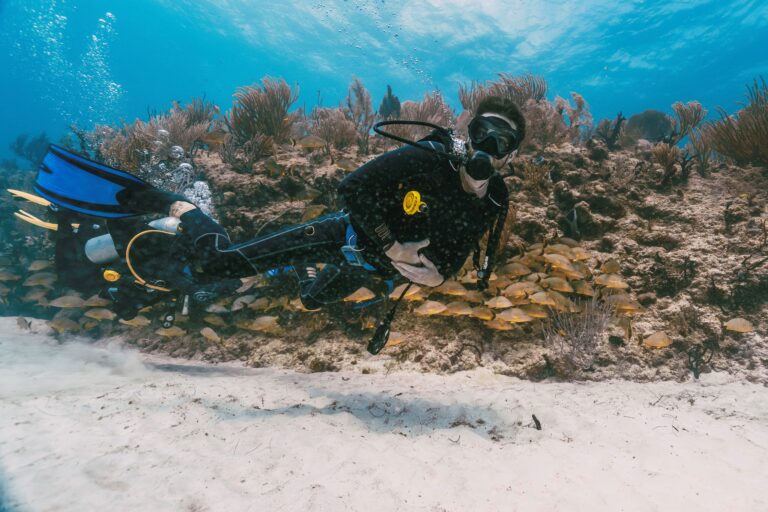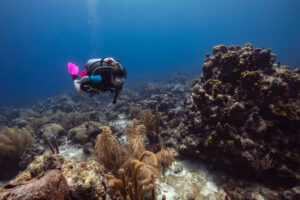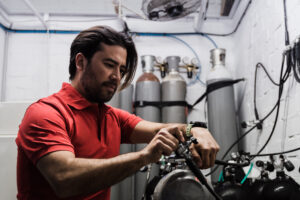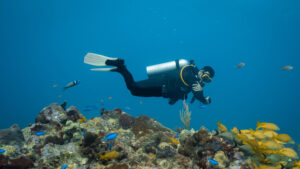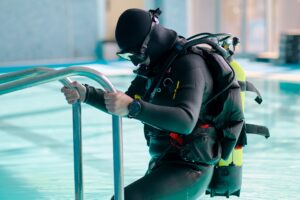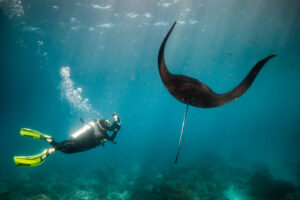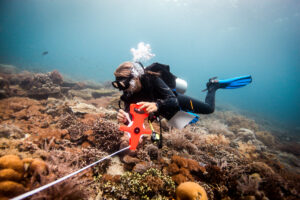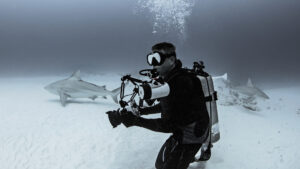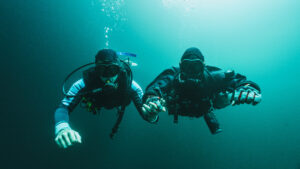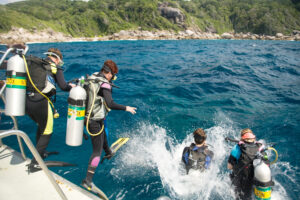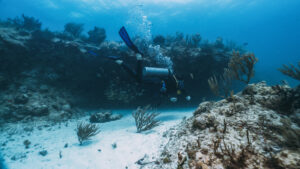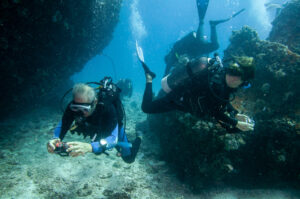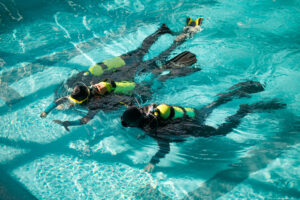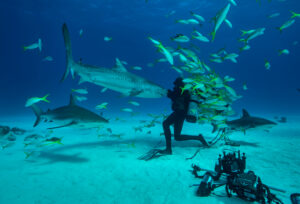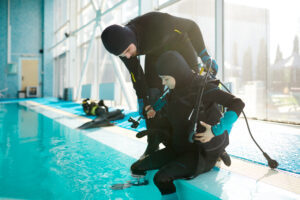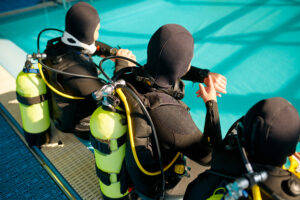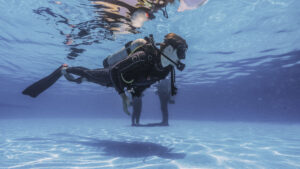What is a Scuba Diver?
A scuba diver is a person who engages in the recreational or professional activity of swimming underwater using SCUBA equipment. The term “scuba” is an acronym for “self-contained underwater breathing apparatus,” which allows scuba divers to breathe comfortably beneath the water’s surface while exploring the aquatic world at their leisure. Scuba diving has grown immensely popular since its inception. There are currently millions of people worldwide participating in the sport. Scuba diving is also a tool that is vital for scientific research and marine conservation efforts.
History of Scuba Diving
Scuba diving traces its roots back to early diving techniques, including the use of diving bells and helmet diving. These methods provided limited mobility and functionality for the diver. The invention of the modern SCUBA system is attributed to Jacques-Yves Cousteau and Emile Gagnan, who developed the “Aqua-Lung” in 1943. This revolutionary device allowed divers to carry their air supply with them, providing unprecedented freedom and enabling deeper and longer underwater excursions.
Equipment used by Scuba Divers
To safely and effectively navigate the subsurface environment, scuba divers depend on a variety of specialized equipment. This equipment is designed to ensure the diver’s safety, provide a stable air supply, and facilitate efficient movement underwater. Critical components of a scuba diving setup include a scuba tank, regulator, buoyancy control device, exposure protection, fins, mask, snorkel, dive computer, and weight system. Together, these elements enable divers to have an enjoyable and secure experience underwater.
Mask
A mask is an essential piece of equipment for scuba divers, freedivers, and snorkelers that provides a clear view underwater. Masks create an air space in front of the divers eyes, enabling the user to see clearly while submerged. They are designed to fit comfortably on the face, ensuring a watertight seal to prevent water from entering and obscuring vision.
Snorkel
A snorkel is a crucial tool for scuba divers. Snorkels allow scuba divers to breathe at the surface without lifting their heads out of the water. This simple device consists of a curved tube with a mouthpiece at one end and an opening at the other to draw in air. Snorkels provide a convenient way for divers to conserve energy and air supply while resting or observing marine life at the surface.
Fins
Fins are an essential part of a diver’s gear, designed to aid movement through the water. Attached to the feet, these large, flat surfaces work on the principle of push and resistance, enabling the diver to propel themselves efficiently in the underwater environment. They come in various designs and stiffness levels to accommodate different diving styles, conditions, and personal preferences. Some divers prefer split fins for their ease of use and energy efficiency, while others favor paddle fins for their power and control.
Scuba Tank
A Scuba tank, also known as a diving cylinder, is a vital piece of equipment in the world of underwater exploration. This high-pressure cylinder is filled with a mixture of compressed air or other breathable gases, such as nitrox or trimix, which the diver uses as a self-contained underwater breathing apparatus (SCUBA). The tanks are typically made from steel or aluminum and come in a variety of sizes and capacities to accommodate different dive durations and depths. Their robust construction ensures that they can safely contain the high-pressure gas, while a valve at the top of the tank controls the release of the gas to the diver’s regulator.
Regulator
A regulator is a critical component of a scuba diving setup, serving as a control mechanism that modulates the flow of air from the high-pressure scuba tank to the diver. It operates by reducing the pressure of the air released from the scuba tank, which can be as high as 3000 psi, to a pressure that is safe and comfortable for the diver to breathe underwater. The regulator is generally composed of two stages: the first stage reduces the pressure from the tank, while the second stage further reduces the pressure just before the diver inhales, making it essential for a safe and enjoyable diving experience.
Buoyancy Control Device (BCD)
The Buoyancy Control Device (BCD) is a piece of scuba diving equipment that greatly enhances the diver’s control over their position in the water. This inflatable vest, worn over the diver’s torso, can be filled or emptied of air to adjust the diver’s buoyancy, allowing them to either float, sink, or maintain a neutral position in the water. This precise control of buoyancy is essential for divers to safely navigate underwater environments, maintain their position at a certain depth, and make controlled ascents and descents.
Exposure Protection
Exposure protection in scuba diving refers to the gear worn by divers to protect against the elements and underwater hazards. This typically includes wetsuits or drysuits, which serve to insulate the diver from the cold, as water conducts heat away from the body far more efficiently than air. Depending on the water temperature, divers might opt for a thin wetsuit, a thick wetsuit, or a drysuit, which is completely waterproof and allows for the wearing of warm clothes underneath. Additionally, these suits provide a protective barrier against potential skin abrasions and stings from marine life.
Dive Computer
A dive computer is a specialized device designed to assist divers in managing their dive profiles. It monitors and displays key information such as current depth, total dive time, and ascent rate. Additionally, most dive computers provide real-time calculations of the diver’s nitrogen absorption, helping to manage decompression requirements and prevent decompression sickness, also known as ‘the bends.’ By doing so, the dive computer plays a crucial role in ensuring the safety and well-being of the diver. Modern dive computers often include additional features such as air integration to monitor tank pressure, digital compasses for navigation, and Bluetooth connectivity for logging dives on personal devices.
Weight System
The weight system is an essential aspect of a scuba diver’s gear, designed to counteract the natural buoyancy of the diver and their equipment. Without additional weight, divers and their gear, especially when wearing buoyant wetsuits, would struggle to descend and remain at the desired depth. The weight system can take various forms, including weight belts, weight harnesses, or integrated weight pockets built into the BCD. The amount of weight used is carefully calculated based on the diver’s body weight, the weight of their equipment, the saltiness of the water, and the type of exposure protection being used. Proper weight distribution also assists with maintaining a comfortable and efficient horizontal position underwater.
ACCESSORIES AND SAFETY EQUIPMENT
In addition to the primary equipment mentioned above, scuba divers often carry a range of accessories and safety gear to enhance their diving experience and prepare for potential emergencies. These items may include dive lights for better visibility in low light conditions or night dives, dive knives or cutting tools for freeing oneself from entanglements, surface marker buoys (SMBs) to signal their location to boats, and audible signaling devices like whistles or air horns for attracting attention on the surface. A compass or underwater navigation system is also helpful for divers to maintain their bearings and find their way back to the dive site or boat.
Training Required to Scuba Dive
Scuba diving requires proper training and certification to ensure the safety of the scuba diver and the protection of the underwater environment. Several organizations, such as PADI, SSI, BSAC, CMAS, and NAUI, offer courses and certifications for scuba divers at different skill levels. Beginner scuba divers typically start with an Open Water certification, which teaches essential skills and knowledge for scuba diving to depths of up to 18 meters (60 feet).
Types of Scuba Diving
Scuba diving is an incredibly diverse activity that encompasses numerous disciplines and specialties, each with its own unique set of experiences and challenges. Among the many types of scuba diving disciplines, some of the most prevalent include recreational diving, underwater photography and videography, technical diving, scientific diving, commercial diving, public safety diving, and military diving.
Recreational Scuba Diving
The most widespread and popular form of scuba diving is recreational diving. This type of scuba diving allows enthusiasts to explore and investigate captivating underwater environments, observe a vast array of vibrant marine life, and experience the exhilaration of weightlessness in a serene aquatic setting. Recreational divers typically adhere to certain depth limits and follow standard safety practices, ensuring that they can enjoy the underwater world while minimizing potential risks.
Underwater Photography and Videography Diving
The mesmerizing underwater world provides scuba divers with a rare opportunity to document and capture stunning images and footage of diverse marine life and environments. Many scuba divers specialize in underwater photography and videography, honing their skills to produce breathtaking visuals that showcase the beauty and complexity of life beneath the waves. These skilled artists often invest in advanced camera equipment and lighting systems, enabling them to capture the vibrant colors and intricate details of their subjects.
Technical Diving
Technical diving, an advanced and specialized form of diving, involves the use of highly specialized equipment and techniques to explore deeper depths, intricate cave systems, and enigmatic shipwrecks. Technical divers often undergo extensive training and gain substantial experience before attempting these challenging dives. This type of diving frequently necessitates the use of complex gas mixtures, decompression procedures, and advanced navigation skills, making it a pursuit for the truly dedicated and adventurous diver.
Scientific Diving
Scuba diving plays an indispensable role in marine research and conservation. Scientists and researchers employ scuba diving techniques to study and monitor fragile underwater ecosystems, collect samples, and conduct experiments that contribute to our understanding of the ocean and its inhabitants. Scientific diving often combines the skills of both recreational and technical diving, with researchers venturing into various environments, from shallow coral reefs to deep-sea ecosystems, to gather valuable data.
Commercial Diving
Commercial diving encompasses a wide range of professional diving tasks in industries such as offshore oil and gas, construction, and underwater engineering. Commercial divers often work in challenging conditions that necessitate specialized skills, equipment, and training. These highly skilled professionals may perform tasks such as underwater welding, pipeline installation, and inspection or maintenance of underwater structures, demonstrating the versatility and adaptability of scuba diving in various industries.
Public Safety Diving
Public safety divers, including members of police, fire, and search and rescue teams, are responsible for conducting critical underwater search and recovery operations. Often working in hazardous environments and under challenging conditions, these courageous divers utilize their scuba diving expertise to locate and recover evidence, rescue victims, and perform other essential tasks that contribute to public safety and security.
Military Diving
Military diving units consist of highly trained, specialized personnel who engage in a wide variety of underwater operations, including reconnaissance, sabotage, search and rescue, and mine clearance. These elite divers often utilize advanced scuba equipment and techniques tailored to their specific mission requirements, showcasing the adaptability and utility of scuba diving in even the most demanding and high-stakes situations. Military divers must possess exceptional physical and mental fortitude, as well as master various specialized skills, such as underwater navigation, covert operations, and the use of cutting-edge technology. The integration of scuba diving into military operations underscores its strategic importance and the diverse range of applications that extend far beyond recreational pursuits.
Conservation and Environmental Impact
Scuba diving offers a unique perspective on the underwater world, fostering a deeper appreciation for the beauty and fragility of marine ecosystems. As a result, many scuba divers become passionate advocates for ocean conservation, supporting initiatives such as coral reef restoration, the reduction of marine pollution, and the establishment of marine protected areas.
However, scuba diving also has the potential to negatively impact the environment if not conducted responsibly. Scuba divers must adhere to guidelines and best practices, including maintaining buoyancy control, avoiding contact with delicate marine life, and refraining from removing or disturbing underwater artifacts. Additionally, responsible dive operators and tourism providers are essential to minimizing the environmental footprint of the diving industry.
Diving Safety and Medical Considerations
Scuba diving is considered a relatively safe sport when practiced responsibly and within the limits of one’s training and experience. However, scuba divers must be aware of potential hazards and medical considerations, including decompression sickness, nitrogen narcosis, and barotrauma. Proper training, equipment maintenance, and adherence to safety guidelines significantly reduce the risk of accidents and injuries.
Scuba divers must also consider their physical fitness and medical history before engaging in scuba diving. Individuals with certain medical conditions, such as asthma, diabetes, or heart disease, may require clearance from a physician before diving. Regular exercise, a balanced diet, and a healthy lifestyle contribute to a safer and more enjoyable diving experience.
Key Takeaways
Scuba diving offers a window into the captivating underwater world, providing unparalleled opportunities for adventure, exploration, and personal growth. By emphasizing safety, responsible practices, and environmental stewardship, scuba divers can continue to enjoy and protect the oceans for generations to come.

